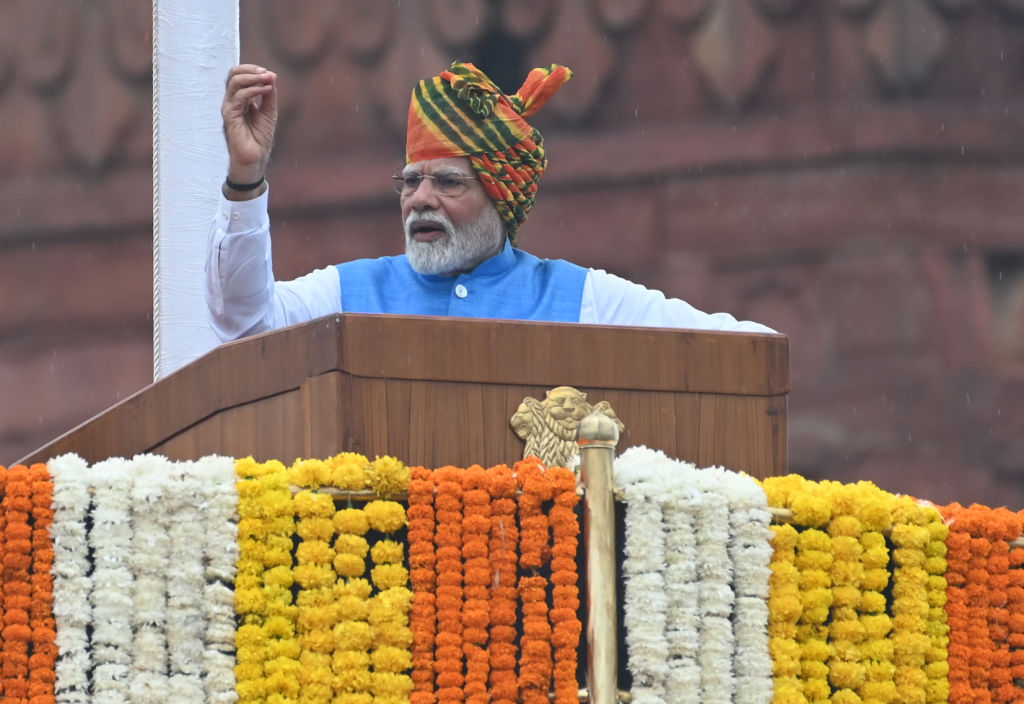The Prime Minister’s 15 August speech from the ramparts of the Red Fort always brings a smile to one and all. However, the 79th Independence Day speech delivered by PM Narendra Modi — in the backdrop of Donald Trump’s tariff policies and geopolitical ruckus — is seen as the Mahabharata’s famous “Sudarshan Chakra” which is on its course to safeguard India’s financial sovereignty from global headwinds and international roadblocks.
Whenever India faces the rattles of international disruptions, the country has bounced back to new heights. Former US president Richard Nixon’s non-cooperation on giving food aid which caused the Green Revolution in India, and in a similar vein the Trump administration’s trade policies levying 50% tax on Indian exporting goods have galvanized several initiatives, including Goods and Services Tax (GST) revamp, that would accelerate the journey towards Viksit Bharat and Samridh Bharat.
In his address, PM Modi rolled out a major promise that has caught the nation’s attention like a festive sparkler. He declared the launch of next-generation GST reforms as a Diwali gift for citizens, saying, “This Diwali, I am going to make it a double Diwali for you.”
This move aims to simplify the tax structure and cut down the burden on everyday people, at a time when global trade tensions are putting pressure on India’s exports. The current GST setup, with rates of nil or zero on essential food items, 5% on daily use products, 12% on standard goods, 18% on electronics and services, and 28% on luxury and sin goods, will give way to just two main slabs: 5% and 18%.
This overhaul is designed to benefit low-income and middle-class families, along with small traders, big businesses, and entrepreneurs, by making goods cheaper and operations smoother.
The announcement has already sent ripples through Dalal Street, with markets cheering the news.
On the first trading day after the speech, the Sensex jumped over 600 points, and the Nifty reclaimed the 25,000 mark, driven by hopes of higher demand in sectors like automobiles and consumer goods.
Experts point out that over 40 stocks from various sectors stand to gain, including names like Tata Motors, Maruti Suzuki, and firms in consumer durables, such as those making refrigerators and air conditioners. Brokerages like Jefferies and Morgan Stanley estimate this could add up to ₹2.4 lakh crore in demand boost, helping lift corporate earnings and overall growth.
Needless to say, the reforms are positioning India as a growth accelerator without buckling under external pressures.
At its core, this GST revamp is built on three key pillars: structural changes, rate cuts, and better ease of living. It matches the government’s drive for an Atmanirbhar India, aiming to make the country the world’s third-largest economy.
By streamlining taxes, it promises to strengthen supply chains and encourage local manufacturing, much like how past challenges spurred self-reliance.
Micro, small, and medium enterprises (MSMEs), which form the backbone of India’s job market, are expected to see major relief through lower costs on inputs and simpler compliance rules. Daily-use items becoming cheaper will not only put more money in people’s pockets but also pump up the economy, where consumption drives over 60% of GDP.
Here are five key understandings on how this will bring a drastic change in people’s lives, creating a wave of feel-good factors across households.
FIRST: The rate cuts will directly ease the load on household budgets, especially for essentials. Items such as food, medicines, and education materials are slated to stay in the 0-5% bracket, which means lower prices for basics that every family relies on.
For the Aam Aadmi juggling rising costs of living, this could translate to savings on monthly groceries and health expenses, freeing up cash for other needs. In rural areas, where food takes up a large chunk of spending, this low-tax approach will act as a buffer against inflation, helping families stretch their rupees further.
SECOND: The scrapping of the 28% slab for many goods will make big-ticket purchases more within reach. Products like air conditioners, televisions, refrigerators, washing machines, and even cars could see their GST drop to 18%, boosting affordability. Cement, a key material for home building, might also fall to 18% from 28%, giving a leg-up to construction and real estate.
Imagine a middle-class family in a city like Mumbai or Delhi finally buying that new fridge without the heavy tax bite – this not only improves quality of life but also sparks more buying, creating jobs in manufacturing and retail.
THIRD: Small businesses and traders will find it easier to operate, thanks to simpler rules and lower rates. Experts say 99% of goods now in the 12% category will move to 5%, while 90% from the 28% bracket shift to 18%.
This will cut compliance hassles for MSMEs, allowing them to focus on growth rather than paperwork. In places like Surat’s textile hubs or Bengaluru’s startup scenes, entrepreneurs could see costs drop, leading to more hiring and innovation. As one analyst noted, this will hugely benefit consumption demand by putting more money into circulation.
FOURTH: The overall economy gets a shot in the arm through higher spending and lower inflation. With tax rationalisation supporting low rates, it will improve the ease of doing business and fuel demand across sectors.
Brokerages predict this could offset any short-term revenue dip -estimated at ₹1.8 lakh crore or 0.5% of GDP – through broader growth and higher collections later.
For the common man, this means steadier prices and more stable jobs, as industries like autos and FMCG ramp up production. Sectors such as hotels, logistics, and retail are also poised for gains, creating a ripple effect that touches every corner of the country.
FIFTH: These changes will nurture a sense of security amid global uncertainties. By responding to trade barriers with home-grown reforms, India shows resilience, much like the Green Revolution era. Public reactions on platforms like X highlight this optimism, with users praising the move as a bold counter to tariffs while boosting domestic strength.
For “Aam Aadmi” (common people), it signifies not only lower prices for goods but also a more optimistic economic outlook, where self-reliance translates to real benefits like affordable homes, better appliances, and stronger livelihoods.
At last, PM Modi’s GST 2.0 is more than a tax tweak — it’s a step towards inclusive growth that puts the common citizen first. While some fiscal costs are inevitable, the long-term gains in consumption and confidence could well make this Diwali twice as bright for millions. As India navigates choppy international waters, such home-front measures will help keep the ship steady, ensuring prosperity reaches the last mile.











